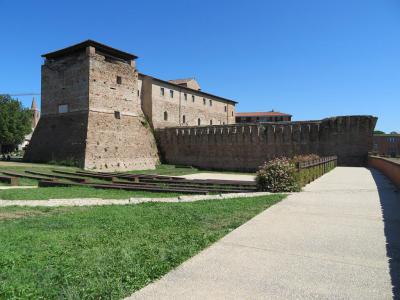
Castel Sismondo (Sismondo Castle), Rimini
The Castle Sismondo is named after its creator, the feudal lord Sigismondo Pandolfo Malatesta. He was lord of Rimini and the coastal town of Fano until he died in 1468. The castle is located in Malatesta Square and is one of the city's most important monuments. Today's remains were once a majestic fortified palace, a manifestation of Malatesta's power and prestige.
Construction began in 1437 and lasted almost 15 years. It is known that Malatesta designed the castle, although several architects worked on the building, including the architect Filippo Brunelleschi, who had also designed the dome of Florence Cathedral.
Enormous towers and dense, slanted walls shaped the castle. The main entrance was guarded by a double ravelin (fortified island) and a drawbridge. The tops of the walls are crenelated with merlons (notched battlements).
The castle covers 3,300 square meters. It has the three-floor Isotta wing for Sigismondo's wife, a central courtyard, and a massive keep. In 1821 the building served as barracks for the local Carabinieri. The walls were partially demolished, and the towers disappeared. Outer walls, the surrounding trench, and what remained of the structure became a prison until 1967.
After a period of decline, the edifice is used for cultural exhibitions. Since 2020, the complex has become a vast museum dedicated to filmmaker Federico Fellini.
Construction began in 1437 and lasted almost 15 years. It is known that Malatesta designed the castle, although several architects worked on the building, including the architect Filippo Brunelleschi, who had also designed the dome of Florence Cathedral.
Enormous towers and dense, slanted walls shaped the castle. The main entrance was guarded by a double ravelin (fortified island) and a drawbridge. The tops of the walls are crenelated with merlons (notched battlements).
The castle covers 3,300 square meters. It has the three-floor Isotta wing for Sigismondo's wife, a central courtyard, and a massive keep. In 1821 the building served as barracks for the local Carabinieri. The walls were partially demolished, and the towers disappeared. Outer walls, the surrounding trench, and what remained of the structure became a prison until 1967.
After a period of decline, the edifice is used for cultural exhibitions. Since 2020, the complex has become a vast museum dedicated to filmmaker Federico Fellini.
Want to visit this sight? Check out these Self-Guided Walking Tours in Rimini. Alternatively, you can download the mobile app "GPSmyCity: Walks in 1K+ Cities" from Apple App Store or Google Play Store. The app turns your mobile device to a personal tour guide and it works offline, so no data plan is needed when traveling abroad.
Castel Sismondo (Sismondo Castle) on Map
Sight Name: Castel Sismondo (Sismondo Castle)
Sight Location: Rimini, Italy (See walking tours in Rimini)
Sight Type: Attraction/Landmark
Guide(s) Containing This Sight:
Sight Location: Rimini, Italy (See walking tours in Rimini)
Sight Type: Attraction/Landmark
Guide(s) Containing This Sight:
Walking Tours in Rimini, Italy
Create Your Own Walk in Rimini
Creating your own self-guided walk in Rimini is easy and fun. Choose the city attractions that you want to see and a walk route map will be created just for you. You can even set your hotel as the start point of the walk.
Federico Fellini Trail
Even those vaguely familiar with cinema perhaps have heard of Federico Fellini. In recent history, the picturesque resort town of Rimini, on the Adriatic coast of Italy, "marked" itself primarily as the birthplace and the final resting place of this great film director.
Fellini lived in Rimini from January 1920, when he was born, until January 1939, when he moved out to Rome. While... view more
Tour Duration: 2 Hour(s)
Travel Distance: 3.4 Km or 2.1 Miles
Fellini lived in Rimini from January 1920, when he was born, until January 1939, when he moved out to Rome. While... view more
Tour Duration: 2 Hour(s)
Travel Distance: 3.4 Km or 2.1 Miles
Rimini Introduction Walking Tour
The Roman Republic founded an outpost called Ariminus at the mouth of the river Marecchia in 268 BC. Rimini was a center of civil wars and invasions. Julius Caesar made his famous "Rubicon" speech to his troops in the city forum.
The city was an all-important junction. The ancient Roman road, via Flaminia, ended in Rimini at the Arch of Augustus, erected in 27 BC. Another old Roman... view more
Tour Duration: 2 Hour(s)
Travel Distance: 2.4 Km or 1.5 Miles
The city was an all-important junction. The ancient Roman road, via Flaminia, ended in Rimini at the Arch of Augustus, erected in 27 BC. Another old Roman... view more
Tour Duration: 2 Hour(s)
Travel Distance: 2.4 Km or 1.5 Miles


